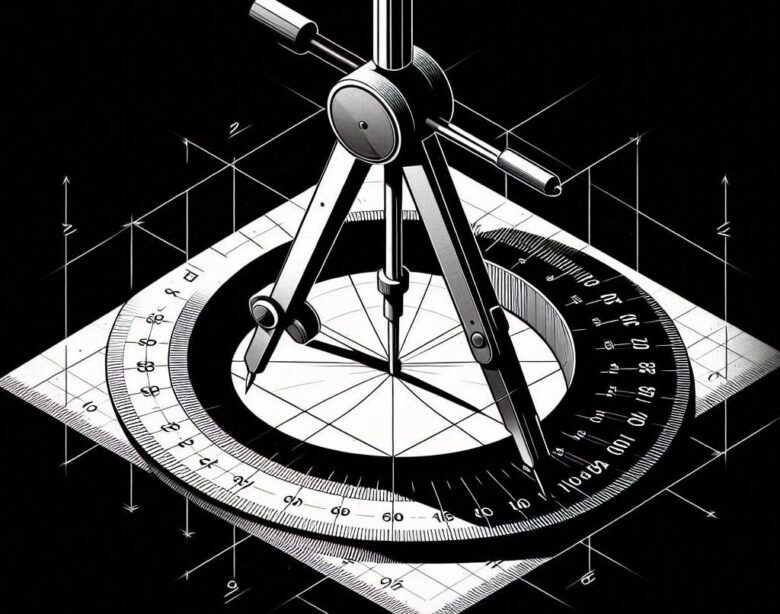The History of Geometric Construction
Geometric construction is one of the oldest and most fundamental branches of mathematics, tracing its origins back to ancient civilizations. The use of geometry to construct shapes, angles, and figures without the aid of measuring tools—other than a compass and straightedge—has fascinated mathematicians for millennia. The principles behind geometric construction have not only shaped the development of mathematics but also had a profound impact on the progress of science, architecture, and engineering.
Early Beginnings: Ancient Egypt and Mesopotamia
The origins of geometric construction can be traced back to the ancient civilizations of Egypt and Mesopotamia, where geometry was primarily used for practical purposes. The Egyptians, for example, relied heavily on geometry for surveying land and constructing the pyramids. Evidence from the Rhind Mathematical Papyrus (c. 1800 BCE) shows that the Egyptians were proficient in solving problems involving the areas of triangles, circles, and other geometric shapes, although their methods were largely empirical rather than theoretical.
In Mesopotamia, the Babylonians made significant advancements in geometry, particularly in the measurement of angles and the use of basic geometric constructions. While their focus was on practical applications in surveying and astronomy, their work laid the foundation for later developments in the field. Babylonian mathematicians used geometry to solve problems related to the division of land and the movement of celestial bodies, offering some of the earliest evidence of using geometry for theoretical purposes.
Despite these early contributions, it wasn’t until the classical Greek period that geometric construction became a formal branch of mathematics, driven by a desire to understand the world through deductive reasoning and logical proofs.
Classical Greece: The Golden Age of Geometric Construction
Geometric construction reached its peak during the classical period of Greek mathematics, particularly through the works of mathematicians such as Thales, Pythagoras, Euclid, and Archimedes. These scholars laid the groundwork for the formal study of geometry, establishing the rules and methods of geometric construction that would influence generations of mathematicians.
Thales of Miletus
Thales (c. 624–546 BCE) is considered one of the first Greek mathematicians to contribute to the field of geometric construction. He is credited with discovering several fundamental geometric theorems, including the Thales’ Theorem, which states that any angle inscribed in a semicircle is a right angle. Thales also used geometric principles to solve practical problems, such as calculating the height of the pyramids in Egypt by using the concept of similar triangles.
Pythagoras and the Pythagoreans
The Pythagorean School, founded by Pythagoras (c. 570–495 BCE), made significant contributions to the study of geometry, particularly in their exploration of number theory and the relationships between geometric figures. The famous Pythagorean Theorem, which establishes the relationship between the sides of a right triangle, is one of the earliest known results in geometric construction. Pythagoras and his followers believed that geometry was fundamental to understanding the universe, and they developed several methods for constructing geometric figures using only a compass and straightedge.
Euclid’s Elements
Perhaps the most influential figure in the history of geometric construction is Euclid (c. 300 BCE), whose monumental work Elements became the definitive text on geometry for over two millennia. Euclid’s Elements systematically presents the principles of geometric construction, beginning with basic definitions, postulates, and axioms, and progressing to more complex constructions and theorems.
One of the most important aspects of Euclid’s work is his focus on compass and straightedge constructions, which involve creating geometric figures without the use of measuring tools like rulers or protractors. These constructions became the gold standard for classical geometry, and many of Euclid’s constructions—such as bisecting an angle or drawing an equilateral triangle—are still taught in geometry classes today.
Euclid’s emphasis on logical proofs and rigorous construction methods set the stage for the development of axiomatic systems in mathematics, influencing not only geometry but also fields like algebra, calculus, and logic.
Archimedes and Geometric Methods
Archimedes (c. 287–212 BCE) was another towering figure in the history of geometry. Known for his work in geometry, calculus, and physics, Archimedes applied geometric construction to solve a variety of problems, particularly in the areas of area and volume. He developed methods for constructing geometric figures that approximated the value of pi, and he used geometric principles to calculate the areas of curved surfaces, such as spheres and cylinders.
Archimedes’ contributions to geometric construction extended beyond theoretical mathematics. His inventions, such as the Archimedean screw and war machines, were based on geometric principles and showcased the practical applications of geometric construction in engineering and mechanics.
The Decline of Classical Geometry and the Islamic Golden Age
After the fall of the Roman Empire, the study of geometry in Europe declined, but it found a new home in the Islamic world during the Islamic Golden Age (8th–14th centuries). Scholars such as Al-Khwarizmi, Omar Khayyam, and Al-Tusi preserved and expanded upon the works of Greek mathematicians, including Euclid and Archimedes.
Islamic mathematicians made important advancements in algebra, trigonometry, and geometric construction, particularly in their attempts to solve classical Greek problems like squaring the circle, doubling the cube, and trisecting an angle. Although these problems were later proven to be impossible using only a compass and straightedge, the efforts to solve them led to the development of new mathematical techniques and tools.
One of the most significant contributions from this period was the development of analytic geometry, which linked algebra and geometry and allowed mathematicians to solve geometric problems using equations. This marked a major shift from purely compass and straightedge constructions to more algebraic approaches to geometry.
The Renaissance and the Birth of Modern Geometry
The Renaissance brought a renewed interest in the works of classical Greek mathematicians, particularly Euclid and Archimedes. Mathematicians such as Leonardo da Vinci, Johannes Kepler, and René Descartes built on the geometric principles of their predecessors, applying them to the emerging fields of physics, astronomy, and engineering.
During this period, perspective geometry became an important tool for artists and architects, allowing them to create realistic three-dimensional representations of objects on a two-dimensional plane. This required an understanding of geometric construction and its application to visual space, leading to further developments in projective geometry.
The most significant advancement in geometry during the Renaissance was the development of analytic geometry by René Descartes (1596–1650) and Pierre de Fermat (1601–1665). Analytic geometry revolutionized the field by providing a way to represent geometric figures using algebraic equations. This allowed mathematicians to solve complex geometric problems using algebraic techniques, and it laid the groundwork for the development of calculus by Isaac Newton and Gottfried Wilhelm Leibniz.
The Role of Geometric Construction in Modern Mathematics and Science
In modern times, geometric construction has continued to play a vital role in mathematics, science, and engineering. Although the limitations of compass and straightedge constructions were recognized in the 19th century (with the proof that certain classical problems could not be solved using these tools alone), the principles of geometric construction remain central to many areas of study.
1. Computer Science and Algorithms
Geometric construction principles have found new life in the field of computer science, particularly in the development of algorithms for computer graphics, computer-aided design (CAD), and robotics. Algorithms for constructing geometric shapes, solving geometric problems, and simulating physical processes are used in a wide variety of applications, from video games to architectural design.
2. Engineering and Physics
In engineering, geometric construction techniques are used to design structures, machines, and systems that function according to precise geometric principles. From the design of bridges and buildings to the development of mechanical devices, engineers rely on geometric methods to ensure that their designs are both functional and aesthetically pleasing.
In physics, geometric construction is used to model physical systems and understand the behavior of objects in space. Concepts such as vectors, coordinate systems, and geodesics are rooted in geometry and play a key role in the study of motion, force, and energy.
3. Education and Geometry
Geometric construction continues to be an important part of mathematics education. It teaches students the value of logical reasoning, problem-solving, and precision. Learning how to construct geometric figures using only a compass and straightedge helps students develop a deeper understanding of mathematical concepts and encourages them to think critically about spatial relationships.
Conclusion
The history of geometric construction is a testament to the enduring power of geometry as a tool for understanding the world. From its early beginnings in ancient Egypt and Mesopotamia to its formalization in classical Greece and its transformation in the modern era, geometric construction has shaped the course of mathematics and science for thousands of years.
Today, the principles of geometric construction continue to influence fields as diverse as computer science, engineering, and physics. By providing a foundation for problem-solving and logical reasoning, geometric construction has left an indelible mark on the history of human thought and remains a vital part of our intellectual heritage.
Please Visit Our Sponsors:
We only support vendors that we use ourselves in our home. The links below are our own links or affiliate links but know that we use all of these now, or have in the past. As the author/creator of this blog, I also tutor mathematics on Wyzant, sell on Etsy, create content on TpT, and learn Korean on Rosetta Stone.





